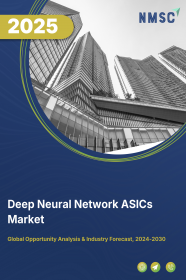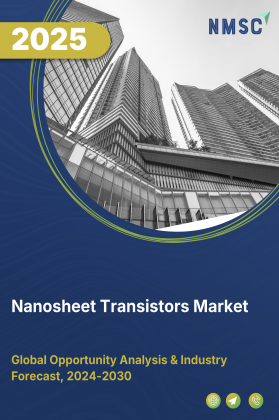
Deep Neural Network ASICs Market by Type (Multi-Layer Perceptrons (MLP), Convolutional Neural Networks (CNN), Recurrent Neural Networks (RNN)), by Application (Pattern Recognition, Natural Language Processing, and Computational Learning) and Others - Global Opportunity Analysis and Industry Forecast 2021-2030
Market Definition:
The Deep Neural Network ASICs Market size was valued at USD XX million in 2020 and is predicted to reach USD XX million by 2030 with a CAGR of XX% from 2021-2030. An Application-Specific Integrated Circuit (ASIC) is a customized version of a general-purpose processor, developed for a specific use. Unlike other chip types such as FPGAs, CPUs and GPUs, ASICs are typically faster and used to perform parallel processing of complex algorithms.
Therefore, companies that use AI technology are inclined towards integrating ASIC into their systems. ASICs are extensively used to handle both training and inference tasks. Most of the time, training a deep neural network, such as Resnet-50 requires high-end computational capabilities, thus making ASICs an obvious choice to train AI models and deliver AI computations.
Market Dynamics and Trends:
Rise in the adoption of AI, across various industry verticals for purposes such as accurate results and high-end work proficiency is a major factor expected to drive the growth of the global deep neural network ASICs market. Also, increasing hardware acceleration and growing demand for faster AI computation among IT companies are factors expected to boost the growth of global deep neural network ASICs market in the coming years.
However, high cost associated with research & manufacturing of such sophisticated chips and time-consuming production process which typically requires a team of 10 to 1000 manpower, depending on the size and complexity of the chip, are the factors that could restrain the growth of market during the forecast period. On the contrary, rise in the number of ASIC launches globally by major players such as Google and Intel are expected to create ample growth opportunities for the market in the coming years.
Market Segmentations and Scope of the Study:
The deep neural network ASICs market is segmented on the basis of type, application, industry verticals, and geography. On the basis of type, the market is divided into Multi-Layer Perceptrons (MLP), Convolutional Neural Networks (CNN), Recurrent Neural Networks (RNN). On the basis of application, the market is classified into pattern recognition, natural language processing, and computational learning. On the basis of industry verticals, the market is categorized into transportation and logistics, manufacturing, energy and utilities, healthcare and life sciences, media, advertising, and entertainment, banking, financial services, and insurance, IT and Telecom, retail and eCommerce, government, and others (travel and hospitality, education, real estate and construction). Geographic breakdown and analysis of each of the aforesaid segments includes regions comprising of North America, Europe, Asia-Pacific, and RoW.
Geographical Analysis:
Asia-Pacific is expected to dominate the global deep neural network ASICs market during the forecast period. This is attributed to factors such as supply of cost-efficient manufacturing facilities in developing countries like China, Taiwan, and India. In addition, increasing adoption of AI powered products across various industries such as BFSI, healthcare, IT and telecom in this region along with growing digitalization is expected to fuel the growth of the market in this region.
However, North America deep neural network ASICs market has garnered the highest revenue in 2021 due to the dominance of major players operating from this region. This is attributed to, deep learning and automotive research in North America that encourages training of algorithms to performing calculations on floating-point variables in order to provide low-precision arithmetic, which in turn increases the effectiveness of the hardware.
Competitive Landscape:
The deep neural network ASICs market is comprised of various market players such as Intel Corporation, IBM Corporation, Qualcomm, Nvidia Corporation, Advanced Micro Devices, Inc., STMicroelectronics, NXP Semiconductors N.V., MediaTek Inc., HiSilicon, and Rockchip. Other players operating in this market include Google LLC, Amazon Web Services, Inc., Microsoft corporation, Apple, Inc., Alibaba Group (Aliyun), Baidu, Inc., Tencent Holdings Ltd., Huawei Technologies Co., Ltd., Facebook, Inc., and others.
These market players are adopting various business strategies and planning expansion of business across various regions to maintain their dominance in the deep neural network ASICs market. For example, in November 14, 2019, Intel launched the Nervana NNP-T1000 for training and NNP-I1000 for inference, an ASIC that stroked the balance between communication, computing, and memory. This allowed energy-efficient and near-linear scaling from small clusters up to supercomputers. The company said that both the products were developed for customers such as Baidu and Facebook as they have massive AI processing needs.
Key Benefits:
-
The deep neural network ASICs market report provides the quantitative analysis of the current market and estimations through 2021-2030 that assists in identifying the prevailing market opportunities to capitalize on.
-
The study comprises a deep dive analysis of the deep neural network ASICs market trend including the current and future trends for depicting the prevalent investment pockets in the market.
-
The information related to key drivers, restraints and opportunities and their impact on the deep neural network ASICs market is provided in the report.
-
The competitive analysis of the market players along with their market share in the deep neural network ASICs market.
-
The SWOT analysis and Porters Five Forces model is elaborated in the study.
-
Value chain analysis in the market study provides a clear picture of the stakeholders’ roles.
Key Market Segments:
By Type
-
Multi-Layer Perceptrons (MLP)
-
Convolutional Neural Networks (CNN)
-
Recurrent Neural Networks (RNN)
By Application
-
Pattern Recognition
-
Computational Learning
-
Natural Language Processing
By Industry Verticals
-
Transportation and Logistics
-
Manufacturing
-
Energy and Utilities
-
Healthcare and Life Sciences
-
Media, Advertising, and Entertainment
-
Banking, Financial Services, and Insurance
-
IT and Telecom
-
Retail and ECommerce
-
Government
-
Others (Travel and Hospitality, Education, Real Estate and Construction)
By Geography
-
North America
-
U.S
-
Canada
-
Mexico
-
-
Europe
-
UK
-
Germany
-
France
-
Italy
-
Spain
-
Rest of Europe
-
-
Asia-Pacific
-
China
-
India
-
Japan
-
South Korea
-
Australia
-
Rest of Asia-Pacific
-
-
RoW
-
UAE
-
Saudi Arabia
-
South Africa
-
Brazil
-
Remaining Countries
-
Key Players
-
Intel Corporation
-
IBM Corporation
-
Qualcomm
-
Nvidia Corporation
-
Advanced Micro Devices, Inc.
-
STMicroelectronics
-
NXP Semiconductors N.V.
-
MediaTek Inc.
-
HiSilicon
-
Rockchip
REPORT SCOPE AND SEGMENTATION:
|
Parameters |
Details |
|
Analysis Period |
2020–2030 |
|
Base Year Considered |
2020 |
|
Forecast Period |
2021–2030 |
|
Market Size Estimation |
Million (USD) |
|
Market Segmentation |
By Type (Multi-Layer Perceptrons (MLP), Convolutional Neural Networks (CNN), Recurrent Neural Networks (RNN)), by Application (Pattern Recognition, Natural Language Processing, and Computational Learning) and by Industry Vertical (Transportation and Logistics, Manufacturing, Energy and Utilities, Healthcare and Life Sciences, Media, Advertising and Entertainment, Banking, Financial Services and Insurance, IT and Telecom, Retail and Ecommerce, Government, and Others) |
|
Geographical Segmentation |
North America (U.S., Canada, Mexico) Europe (UK, Germany, France, Italy, Spain, Rest of Europe), Asia-Pacific (China, Japan, India, Australia, South Korea, Rest of APAC), Rest of the World (UAE, Saudi Arabia, South Africa, Brazil, Remaining Countries) |
|
Companies Profiled |
Intel Corporation, IBM Corporation, Qualcomm, Nvidia Corporation, Advanced Micro Devices, Inc., STMicroelectronics, NXP Semiconductors N.V., MediaTek Inc., HiSilicon, and Rockchip. |

















 Speak to Our Analyst
Speak to Our Analyst

























